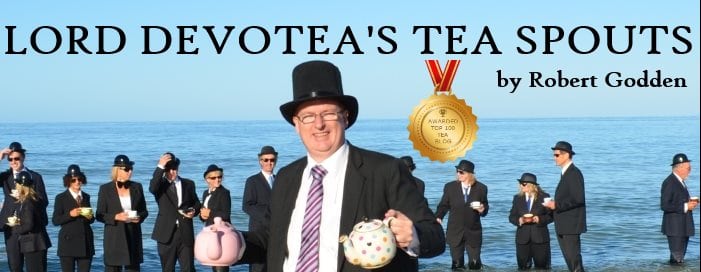A post about Sencha?
Well, no. Not really.
Though a man dressed as Father Christmas once bought some Wild Cherry Sencha from our tea shop long ago and inspired the title, this is a post about words.
Two words: One of them is utilitarian, one quite delightful.
Seen as interchangeable, but I’d argue against it being so.
The first word is ‘flavoured’.
The second word is ‘scented’.
Yes, scented.
Don’t you think “scented tea” is a very different sounding beast to ‘flavoured teas’?
“Scented” is perhaps old fashioned. I usually hear it from over-50s, but on Sunday last, it was used by a 20-something in casual conversation. That’s more the exception that the rule.
I like the idea of ‘scented’ because it implies harmonious meeting of flavours, not a superimposition of one on the other like ‘flavoured’ does. I mean, chocolate flavoured milk tastes like chocolate, not milk. Pineapple-flavoured jelly tastes like pineapple not gelatin and strawberry-flavoured mousse tastes like strawberries, not elk.
But when you describe something as ‘scented’, it implies a gentler effort. A hint of jasmine, a suggestion of lemon, a touch of mint, a smidge of blackberry, a rumour of cherry, a suggestion of butterscotch, an allegation from unknown sources of smoky tar.
When excellent jasmine teas are made, they are made by picking jasmine buds that are about to bloom, introducing them into the presence of green tea leaves, and removing them after the scent has mingled with the tea. A great example of ‘scented tea”.
A good Earl Grey should still taste like tea; a great Lapsang Souchong is undeniably smoky but just as undeniably tea.
So, can we separate teas into ‘scented’ where the flavour additions are subtle, and “flavoured’ where the flavour is all-powerful?
No, I don’t think so.
The problem here is one of grades. I think our Jim’s Caravan (avail UK & Aust only) is so subtly smoky that ‘scented’ works well, but our Lady Devotea blend (Aust only) is full-on flavour.
Even more difficult is our Liquorice White Tea Concoction (Aust Only) which has virtually no liquorice taste at three minutes and is overwhelmed by it at about 6½ minutes of brewing.red. But then, our new Rose Blush (Aust only), when drunk black, is quite subtle, whereas if you add milk and sugar, the rose and vanilla combination is highlighted so much that it is like a hot milkshake. (Yes, that’s right, a hot, delicious, sweet, vanilla and rose milkshake. It is that good!).
So, in short, I have a way of categorising that whilst it’s great in theory, gets lost in practice.
Feel free to comment. However, if your comment is in general terms “Camellia Sinesis good, anything else bad” , then I invite you to read my blog of a few weeks ago first. Saves you looking like a full-flavoured opinionated ass.



The way I see it the difference between scented and flavored is related to smell and taste. A scent is a fragrance we can smell and a flavor is something we can taste. A tea is scented with Jasmine petals because the petals impart their fragrance onto the tea leaves – and a tea is flavored with chocolate nibs or vanilla beans or other additives whose primary function is to be tasted.
The term “scented” teas make me think of soap and perfume so I don’t like the term so much for tea – however I do think it’s the right word for Jasmine, Oil of Bergamot and Lapsang Souchong teas.
I agree with most of what Jackie said, however, there is a point where I’d disagree.
I agree with what she said about scented tea … a tea that is layered with jasmine petals or rose petals to impart the floral essence is what I’d call scented.
I disagree with the flavoring explanation. A
a flavored tea is a process where flavored essences are added. Not nibs or vanilla beans, but instead, flavoring oils that are used to impart the flavoring into the tea.
Adding items such as cacao nibs or vanilla beans would be what I refer to as blending, which can also mean blending different types of tea leaves, herbs, spices, and/or dried fruit, nuts and such to the tea to impart some flavor into the finished brew.
I, for one, am a fan of scented teas. One of the best “alcy-teas” I ever handed was aged in a wine barrel. That and I find the process to be more natural than just splashing a chemical on it. Although, I’ve had a few of those I’ve liked, too.
Yes, I liked the tea that Steven Smith did in the whiskey barrel … I’d consider that to be scented as well.
It all comes down to balance. Flavoring/scenting is easily and usually overdone. But if you find that rare balanced flavoured/scented tea the method by which it was modified no longer methods.
But why all the fuss if you can have a great pure tea on its own. (duck)
It all comes down to balance. Flavoring/scenting is easily and usually overdone. But if you find that rare balanced flavoured/scented tea the method by which it was modified no longer matters.
But why all the fuss if you can have a great pure tea on its own. (duck)